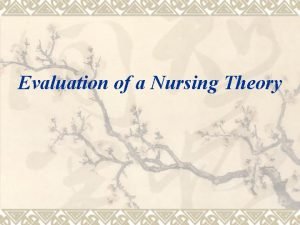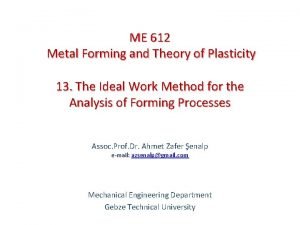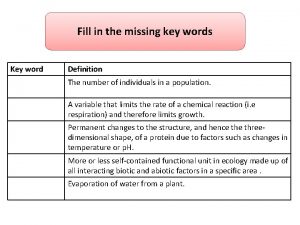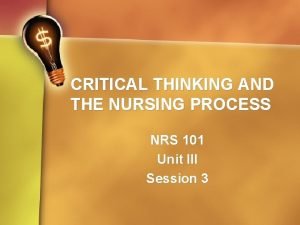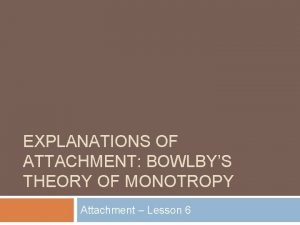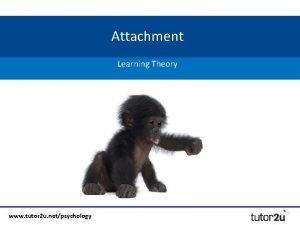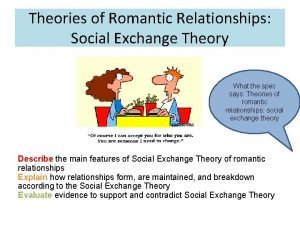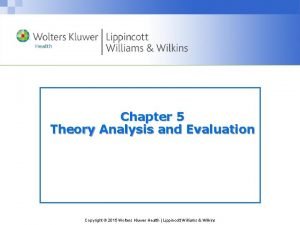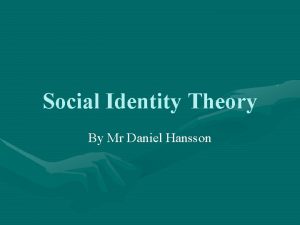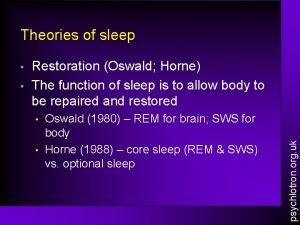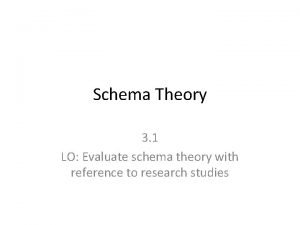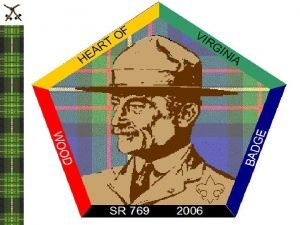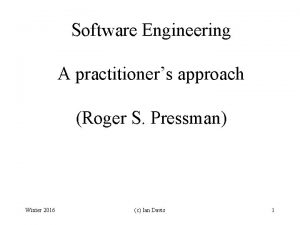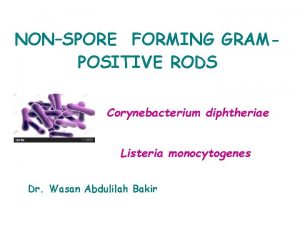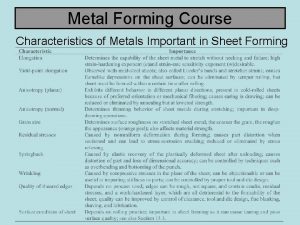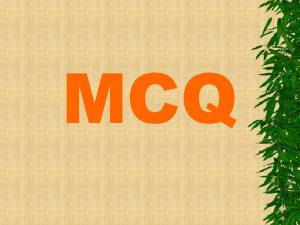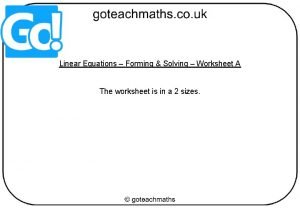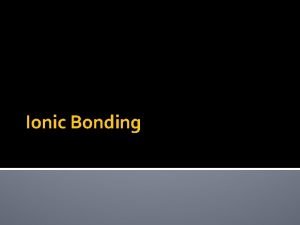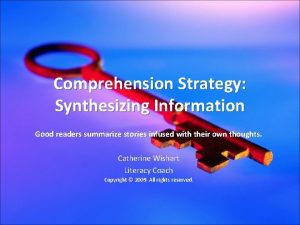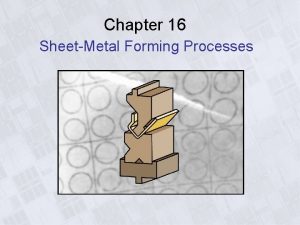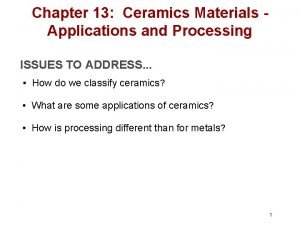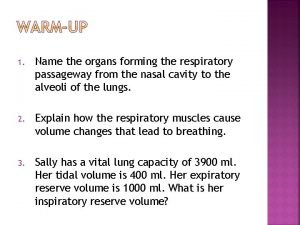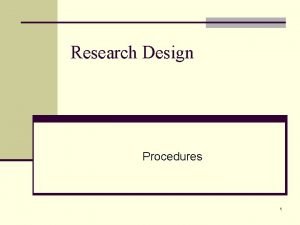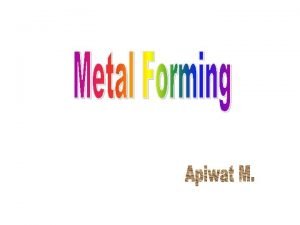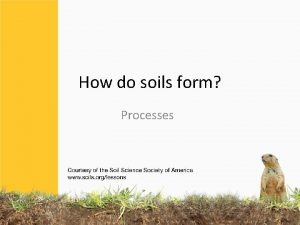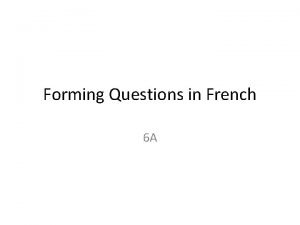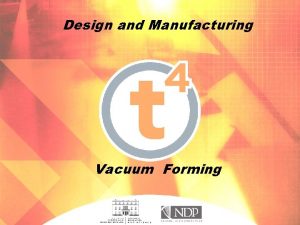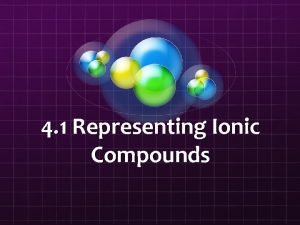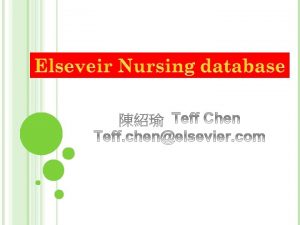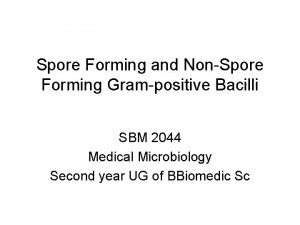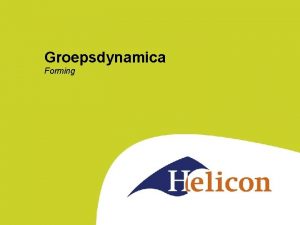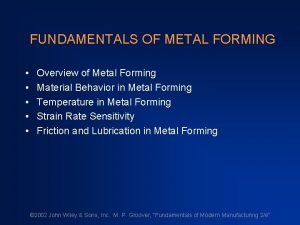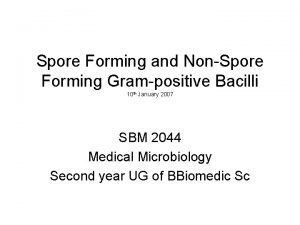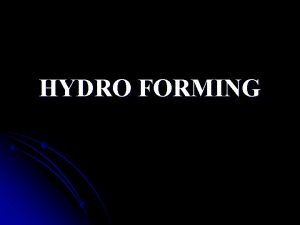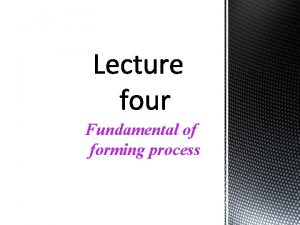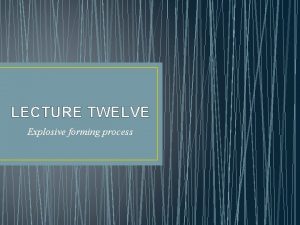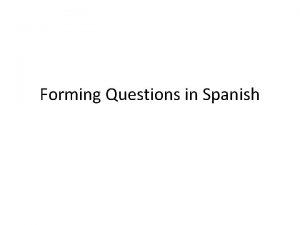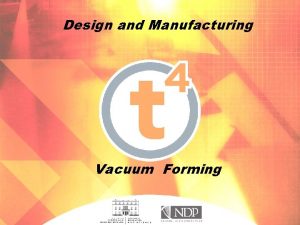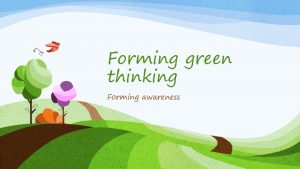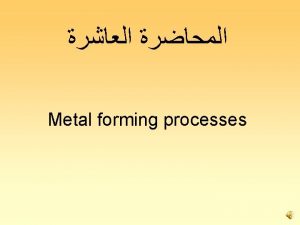Evaluation of a Nursing Theory Forming a Complete










































- Slides: 42

Evaluation of a Nursing Theory

Forming a Complete Description: Six Questions are Propose for Describing Theory.

1. What is the purpose of this theory? This question addresses why theory was formulated and reflects the contexts and situations to which theory can be applied. 2. What are the concepts of this theory? This question identifies the ideas that are structured and related within theory. It questions the qualitative and quantitative dimensions of concepts. 3. How are the concepts defined? This question clarifies the meaning for concepts within theory. It questions how empiric experience is represented by the ideas within theory.

4. What is the nature of relationships? This question addresses how concepts are linked together. It focuses on the various forms relationship statements can take and how they give structure to theory. 5. What is the structure of theory? This question addresses the overall form of the conceptual interrelationships. It discerns whether theory contains partial structures or has one basic form. 6. On what assumptions does theory build? This question addresses the basic truths that underlie theoretic reasoning. It questions whether assumptions reflect philosophic values or factual assertions.

Guide for the Description of Theory 1. PURPOSE v Why is theory formulated? v Is there an overall purpose for theory? A hierarchy of purposes? Separate numerous purposes? v Is there a purpose for the nurse? The person receiving care? Society? Environment? v How broad or narrow is the purpose? v What is the value orientation of the purpose? Positive, negative, neutral?

1. PURPOSE v Does achieving theoretic purpose require a nursing context? v Does the purpose reflect understanding? Creation of meaning? Description, explanation, and prediction of phenomena? v When would theory cases to be applicable? What is the end point? v What purpose not explicitly(明確地) embedded( 植入) in the matrix of theory can be identified?

2. CONCEPTS v Is there one major concept with sub-concepts organized under it? v How many concepts are there? v How many major (or minor) ones? v Can the concepts be ordered, related? Arranged into any configuration?

2. CONCEPTS v Are there concepts that cannot be interrelated? v Are concepts broad in scope? Narrow? v How abstract(抽象) or empiric(經驗) are the concepts? v What is the balance between highly abstract and highly empiric concepts?

3. DEFINITIONS v Which concepts are defined? Which are not? v Which concepts are defined explicitly? Which are implied(隱喻)? v How much meaning needs to be inferred ? v Which concepts are defined specifically? Generally? v Are there competing definitions for some concepts? Are there similar definitions for different concepts? v Are any concepts defined contrary to common convention(習俗, 常規)?

4. RELATIONSHIPS v What are the major relationships within theory? v Which relationships are obvious? Which are implied? v Do relationships include all concepts? Which are not included? v Are some concepts included in multiple relationships? v Is there a hierarchy of relationships? Do relationships create meaning and understanding? Do they do this by describing, explaining? Predicting? What mix of each? v Are relationships illustrated?

5. STRUCTURE v How are overall and individual ideas organized? v If outlined, what would theory look like? v Do relationships expand concepts into large wholes or vice versa(反之亦然)? Do they link concepts in a linear fashion? v Does the structure move concepts away from or toward the purposes? v Are there several structures that emerge(浮現)? What is their form? Do they fit together?

6. ASSUMPTIONS v What assumptions underlie theory? Are assumptions explicit, implicit, or derivable(可推論 的) from context and meanings? v What are the individual, nurse, society, environment, and health assumed to be like? v Do assumptions have an obvious value orientation? What is it? v Could assumptions be factually verified? v Can assumptions be hierarchically arranged or otherwise ordered?

Criteria for the Evaluation of Theory v Dudley-Brown, S. L. (1997). The evaluation of nursing theory: a method for our madness. International Journal of Nursing Study, 34(1), 76 -83.

Accuracy (正確,準確度) v Accuracy, according to Webster’s, as a noun, is defined as exactness or precision, while as an adjective, as without mistakes or errors. v Kuhn (1977) accuracy as a characteristic of a good theory. v Synonyms(同義字) of accuracy include perfect, just, truthful, and correct. v In relation to nursing theory, accuracy pertains(附屬 ) to describing nursing as it exists today, not the nursing of the future or of the past.

Consistency (一致,相容) v Consistency is used frequently in describing criteria for the evaluation of theory. v Kuhn (1977) describes consistency in terms of theory being internally consistent as well as being consistent with accepted theories. v Internal consistency, however, has been described by another philosopher, Newton. Smith (198 l), as consistency in language, the existence of logical order, and connectedness.

Consistency v Inconsistencies should be avoided, a theory with an inconsistency does not necessitate that the whole theory be scrapped(碎片). v Meleis (1985)describes, is to have consistent operational definitions and concepts that are consistent with assumptions and propositions. v Meleis also uses the terms coherent and logically presented to describe clarity.

Fruitful (效果好的,收益多) v Fruitful, is related conceptually to criteria proposed by others. v Synonymous with fertile, bountiful, productive, and prolific. v Kuhn (1977), in describing fruitful, states that theory should expose new feelings, new phenomenon, or previously unknown relationships among phenomenon already known. v Fruitful refers to success in explaining observable phenomenon, and the evaluation of empirical work resulting from a theory.

Fruitful v Newton-Smith (1981) describes (fertile) as the scope for further development. v The theory should contain ideas to further research. v Consistent with this is Ellis’s (1968) criteria of generation of information-the theory should generate hypotheses. v Ellis (1968) states “A theory that generates many hypotheses, even some without high probability, or some that are difficult to test, can contribute to understanding.

Simplicity(單純;簡單) Simplicity as an important evaluative criterion (Kuhn, 1977; Newton-Smith, 1981; Chin and Jacobs, 1983) others propose complexity (Ellis, 1968; Barnum, 1990). v Meleis (1985) takes a more pragmatic(務實的) approach: whether theory has a lot of phenomena and relationships (complexity) or if it focuses on fewer concepts and few relationships (simplicity)? v Kuhn’s, (1977) describes as “bringing order to phenomenon that in its absence would be isolated and confused”. v Simplicity is a seemingly(表面上 ) useful characteristic of a good theory in nursing, and important in the evaluation of nursing theory. v

Scope(範圍) Scope has been dichotomized as either broad or narrow. v Ellis (1968) and Hardy (1974). “The broader the scope, in terms of the number and variety of facts or concepts related, the greater is the significance of theory”. v Hardy (1974) states “the more general a theory, the more useful it is. ” v Broad vs. narrow scope can also be dichotomized in relation to its generalities, or the use of the term theory and conceptual framework/ model. v Scope may be conceptualized in relation to the level of theory, eg. a grand theory or middle range theory. v

Acceptance Meleis (1985)states acceptance “when theory begins to cross several concentric circles from where it originated, its circle of contagiousness(蔓延的) increases and we can infer that theory is receiving more acceptability, uninfluenced by theorist”. v Laudan (1977) discusses the importance of acceptance and pursuit by other members of the discipline in that theory shows promise if others are accepting and ‘buying into’ theory. v It is important for the advancement(促進) of nursing as a profession to have members of the discipline communicate regarding its multicultural acceptance and adoption(採用 ) by others. v

Testability refers to theory’s research potential or empirical adequacy. v Testability has been long felt to be an important criterion for the evaluation of nursing theory, and touted (招徠) as a method to advance the science of nursing. v Acton et al. (1991)and Silva (1986) describe how the lack of empirical validation of nursing theory has hindered the development of nursing science. v Silva and Sorrel 1 (1992) have proposed criteria for evaluating theory-testing research, and discuss important philosophical and methodological issues in the testing of nursing theory. v

Socio-cultural utility encompasses(包圍) social congruence(適合) and social significance v Johnson (1974), Meleis (1985) and Fawcett (1989)in their criteria for the evaluation of theory. v Social congruence encompasses the beliefs, values and expectations of different cultures that should shape and direct the type of theory most useful to it. v As Meleis (1985) explains, self-care and independence are goals consistent with some cultures’ value systems but not others. v Theories with such goals would be incongruent(不一致 的) and inappropriate in some societies and cultures, and should be avoided. v

Conclusion of criteria for the evaluation of theory Nurses in all roles will hopefully use these criteria proposed here to guide their choice of theory when using nursing theory in practice, education and research. v There has been a dearth (缺乏) of empirical testing of theories in nursing, testing is only one part of the evaluation of theory. v A set of criteria for the evaluation of theory has been proposed here that includes: accuracy, consistency, fruitfulness, simplicity/complexity, scope, acceptability and socio-cultural utility. v

Theory Critique v Meleis, A. I. (2007). Theoretical Nursing: Development & Progress (4 rd ed. ). Philadelphia. PA: Lippincott. (Ch 9)(pp. 186 -211)

Table 11 -5 THEORY CRITIQUE— RELATIONSHIP BETWEEN STRUCTURE AND FUNCTION; DIAGRAM OF THEORY; AND CIRCLE OF CONTAGIOUSNESS CRITERIA Relationship between structure and function Diagram of theory Circle of contagiousness UNITS OF ANALYSIS Clarity Consistency Simplicity/Complexity Tautology(同義反複 )/Teleology(目的論) Visual and graphic presentation Logical representation Clarity Geographical origin of theory and geographical spread influence of theorist vs. theory

Table 11 -6 THEORY CRITIQUE—USEFULNESS CRITERIA UNITS OF ANALYSIS Practice Direction Cost effectiveness Applicability Relevance Generalizability Consistency Predictability Testability Philosophical statement Concepts Objectives Structure of care Organization of care Guidelines for patient care Patient classification system Research Education Administration

Table 11 -7 THEORY CRITIQUE—EXTERNAL COMPONENTS OF THEORY CRITERIA Personal values UNITS OF ANALYSIS Theorist implicit/explicit values Critic implicit/explicit values Congruence with other professional values Complementarity(補足) Esotericism(祕傳性) Competition Beliefs Values Customs Value to humanity Congruence with social values Social significance

Forming a complete critical reflection Is this clear? v This question addresses the clarity and consistency of presentation. v Clarity and consistency may be both semantic and structural. 2. Is this simple? v This question addresses the number of structural components and relationships within theory. v Complexity implies numerous relational components within theory; simplicity implies fewer relational components. 1.

Forming a complete critical reflection 3. Is this general? v This question addresses the scope of experiences covered by theory. v Generality infers a wide scope of phenomena, whereas specificity narrows the range of events included in theory. 4. Is this accessible? v This question addresses the extent to which concepts within theory are grounded in empirically identifiable phenomena. 5. Is this important? v This question addresses the extent to which theory leads to valued nursing goals in practice, research, and education.

Guide for the critical reflection of theory 1. HOW CLEAR IS THEORY? v Are major concepts defined? v Are significant concepts not defined? Are definitions clear? Congruent(適合的)? Consistent? v Are words coined? Are coined words defined? v Are words borrowed from other disciplines and used differently in this context? v Is the amount of explanation appropriate? Too much? Not enough? v Are examples or diagrams helpful? meaningful? v Not helpful? Needed and not present?

1. HOW CLEAR IS THEORY? Are basic assumptions consistent with purposes? v Is the view of person and environment compatible(能共處 )? v Are the same terms defined differently? v Are different terms defined similarly? v Are concepts used in a manner consistent with their definition? v Are compatible and coherent(協調一致的) structures suggested for different parts of theory? v Can theory be followed? v Are there any ambiguities(模稜兩可) as a result of sequence of presentation? v Does theorist accomplish what she or he sets out to do? v

2. HOW SIMPLE IS THEORY? v How many relationships are contained within theory? v How are the relationships organized? v How many concepts are contained in theory? v Are some concepts differentiated into sub-concepts? v Can concepts be combined without losing theoretic meaning? v Is theory complex some areas and not in others? v Does theory tend to describe, explain, or predict? Impact understanding? Create meaning?

3. HOW GENERAL IS THEORY v How specific are the purposes of this theory? Do they apply to all or only some practice areas? When? v Is thus theory specific to nursing? If not, who else could use it? Why? v Is the purpose justifiably a nursing purpose? v If subpurposes exist, do they reflect nursing actions? How broad are the concepts within theory?

4. HOW ACCESSIBLE IS THEORY Are the concepts broad or narrow? v How specific or general are definitions within theory? v Are the concepts’ empiric indicators identifiable in reality? Are they within the realm of nursing? v Do the definitions provided for the concepts adequately reflect their meanings? v Is a very narrow definition offered for a broad concept? A broad meaning for a narrow concept? v If words are coined, are they defined? v

5. HOW IMPORTANT IS THEORY? v v v Does theory have potential to influence nursing actions? If so, to what end? Does theory influence nursing education? research? If so, to what end? Is that end desirable? Hoe specific are the purposes of theory? Do they provide a general framework within which to act or a means to predict phenomena? Is theory’s position about people, about nursing, and about the environment consistent with nursing’s philosophy? Given the purpose of theory and its orientation, what of significance for nursing or health care has been omitted?

5. HOW IMPORTANT IS THEORY? Is the started or implied purpose one that is important to nursing? Why? v Will use of theory help or hinder nursing in any way? v Will application of this theory resolve any important issues in nursing? Will it resolve any problems? v Is theory futuristic and forward-looking? v Will research based on theory answer important questions? v Are the concepts within the domain of nursing? v Do I like this theory? Why? v


Conclusion Theory development and evaluation are cyclical, continuous, and dynamic process. One can not exist without the other. v Theory evaluation including description, concept analysis, theory critique, testing and support. v These process are based on the view that science is a human process that includes not only valid findings but also observation, agreements, useful solutions to problems. v Theory evaluation is central to the development of theory; it is the responsibility of each clinician, academician. v

Conclusion Kuhn(1977) “we can delineate such criteria and that accuracy, consistency, broad scope, simplicity and fruitfulness in research are essential as objective criteria for judging competing theories” v However, “every individual's choice between competing theories depends on a mixture of objective and subjective factors” v The subjective factors are dependent on individual's preferences and personalities. v Both objective and subjective factors have a place in our understanding of the philosophy of science. v

Adaptation Model

Exercise: Application of Roy's Adaptation Model in Nursing Practice http: //currentnursing. com/nursing_theory/appli cation_Roy's_adaptation_model. html 1. What is the purpose of this theory? 2. What are the concepts of this theory? 3. How are the concepts defined? 4. What is the nature of relationships? 5. What is the structure of theory? . 6. On what assumptions does theory build?
 Nursing theory evaluation criteria
Nursing theory evaluation criteria Theory of metal forming
Theory of metal forming Complete the missing word to complete the three key words
Complete the missing word to complete the three key words Complete subjects
Complete subjects Example of community health nursing diagnosis statement
Example of community health nursing diagnosis statement Collaborative interventions nursing
Collaborative interventions nursing Ineffective childbearing process example
Ineffective childbearing process example Critical thinking in nursing process
Critical thinking in nursing process Explanations of attachment bowlby's theory
Explanations of attachment bowlby's theory Tutor 2 u psychology
Tutor 2 u psychology Evaluate schema theory
Evaluate schema theory Examples of social exchange theory
Examples of social exchange theory Synthesized method for theory evaluation
Synthesized method for theory evaluation Social identity theory evaluation
Social identity theory evaluation Oswald restoration theory
Oswald restoration theory Evaluate
Evaluate Total patient care nursing model
Total patient care nursing model Nursing interventions for ocd
Nursing interventions for ocd Post operative nursing management of cataract
Post operative nursing management of cataract Nursing process in psychiatric nursing
Nursing process in psychiatric nursing Forming-storming-norming-performing
Forming-storming-norming-performing Storming norming conforming performing
Storming norming conforming performing Sheet metal working adalah
Sheet metal working adalah Corynebacterium diphtheriae spore forming
Corynebacterium diphtheriae spore forming Hot and cold forming
Hot and cold forming Fine blanking
Fine blanking Mcq on sheet metal forming
Mcq on sheet metal forming Forming and solving equations worksheet
Forming and solving equations worksheet Forming equations worksheet
Forming equations worksheet Ionic bonding problems
Ionic bonding problems Synthesizing information allows a reader to
Synthesizing information allows a reader to Forming process in sheet metal
Forming process in sheet metal Particulate forming ceramics
Particulate forming ceramics Organs forming the respiratory passageway
Organs forming the respiratory passageway Forming research design
Forming research design Wholesale sheet metal process
Wholesale sheet metal process 4 soil forming processes
4 soil forming processes Forming questions in french
Forming questions in french Formech vacuum former
Formech vacuum former Forming questions in spanish
Forming questions in spanish Vacuum forming companies near me
Vacuum forming companies near me Malignant neoplasm of the blood-forming organs
Malignant neoplasm of the blood-forming organs In forming ionic bonds
In forming ionic bonds
